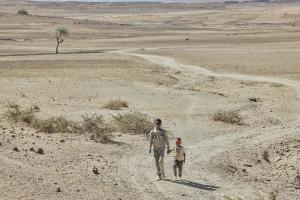Ethiopia’s Largely Unreported Hunger Crisis Is An Unfolding Catastrophe
Millions in Tigray are experiencing emergency levels of hunger and children have lost years of education.
As the Famine Early Warning System (FEWS) Net report predicted, Ethiopia is in crisis now, and Mary’s Meals has witnessed evidence of it regionally across its programs in Tigray following a recent team visit there. “It’s hard to exaggerate just how serious the situation is in Tigray. People are already dying of hunger, and everything we're hearing on the ground points to a well-founded fear of much worse to come if the world doesn’t respond. We’ve heard accounts of children who no longer feel the pain from hunger pangs, not because they have eaten, but because they don’t have the energy to feel pain anymore,” says MacFarlane-Barrow.
More than 91% of Tigray’s population has been “exposed to the risk of starvation and death,” according to the president of Tigray’s Interim Regional Administration, Getachew Reda, and millions are in desperate need of food aid. From 2020 to 2022, the region endured two years of deadly civil war that displaced millions, destroyed essential infrastructure and health services, and is estimated to have claimed the lives of upwards of 600,000 people. Interruptions to aid supplies in 2023, compounded by several failed rainy seasons in recent years resulting in severe drought, have left lives and livelihoods in ruins and accelerated the region’s humanitarian crisis. Currently, the Integrated Food Security Phase Classification (IPC) hunger projections suggest that the majority of Tigray is experiencing IPC Phase 4 emergency levels of hunger, with predictions that “some households will likely be in Phase 5 catastrophe/famine by July.”
In the biggest hospital in the region’s capital of Mekelle, Dr. Abraha Gebreegziabher, a local pediatrician, explains to Mary’s Meals that more and more children are dying from malnutrition in his hospital. “We are seeing three times as many cases of malnutrition as normal, and the mortality rate is five times higher. The number of children dying from malnutrition was quite stable for the last 13 years, but since the war, it’s doubled. Previous deaths were generally linked to other health conditions, but now malnutrition is a singular cause on its own,” he said.
At a time when journalists are struggling to gain access to the area, this situation is going largely unreported.
At stake are the lives of children, as years of disruption, conflict, displacement, drought, and disease mean that millions of children are out of school. Regional statistics suggest that more than half of all primary-age children in Tigray (53%) are not currently enrolled. The situation is made worse by serious staff shortages and damage to school buildings sustained during the conflict; approximately 15,000 teachers are still unaccounted for, and 95% of classrooms in the Central Zone of Tigray, an area where much of Mary’s Meals school feeding takes place, are damaged because of the war.
“It’s hard not to make comparisons between how the world was so moved to act nearly 40 years ago when Ethiopia was gripped by the infamous famine of the 1980s and the situation today that is virtually being ignored. We need to make sure that the terrible outcome Tigray is heading for doesn’t happen, but it will if we don’t act now,” MacFarlane-Barrow says.
Since 2017, Mary’s Meals has worked with a trusted local partner to mobilize local communities to serve nutritious school meals in places of education to generate long-term community-led growth and resilience through education and nutrition. During the conflict, while school feeding had to pause, Mary’s Meals continued working with its partner that pivoted to emergency feeding and other essential support for more than 30,000 internally displaced people sheltering in camps.
Last fall, Mary’s Meals reinstated school feeding as soon as schools began reopening. Today, it is providing meals to more than 45,000 children in Tigray every school day, having almost doubled the size of the program since Christmas. Additionally, Mary’s Meals partner is poised to extend the program to new schools and reach thousands more children, as funds allow. All of the schools where Mary’s Meals programs operate are in areas currently projected to be in Phase 4 emergency, the second highest category for food insecurity.
About Mary’s Meals
Now in its 22nd year, Mary’s Meals is a global movement that sets up school-feeding programs in some of the world’s most vulnerable communities, where conflict, poverty and hunger often prevent children from gaining an education. Mary’s Meals works with in-country volunteers to provide one daily nutritious meal in a place of learning to attract children into the classroom to receive an education. This simple solution to help end world hunger also enables children to lift themselves from the cycle of hunger and poverty.
Mary’s Meals began by feeding 200 children in Malawi in 2002. Today, the organization feeds 2,429,182 hungry children every school day in 5,084 schools across five continents in the following countries: Benin, Ecuador, Ethiopia, Haiti, India, Kenya, Lebanon, Liberia, Madagascar, Malawi, Myanmar, Niger, South Sudan, Syria, Thailand, Yemen, Zambia, and Zimbabwe. For more information about Mary’s Meals, visit https://www.marysmealsusa.org
For photos, videos and to arrange interviews, contact Helena Finnegan, Communications Manager, helena.finnegan@marysmeals.org, 239-290-7788
Paul McMahon
Mary's Meals USA
+1 781-910-0904
paul.mcmahon@marysmeals.org
Visit us on social media:
Facebook
Twitter
Instagram
YouTube
An inside perspective on the worsening hunger crisis in Tigray, Ethiopia from Magnus MacFarlane-Barrow, CEO, Mary's Meals
Legal Disclaimer:
EIN Presswire provides this news content "as is" without warranty of any kind. We do not accept any responsibility or liability for the accuracy, content, images, videos, licenses, completeness, legality, or reliability of the information contained in this article. If you have any complaints or copyright issues related to this article, kindly contact the author above.


